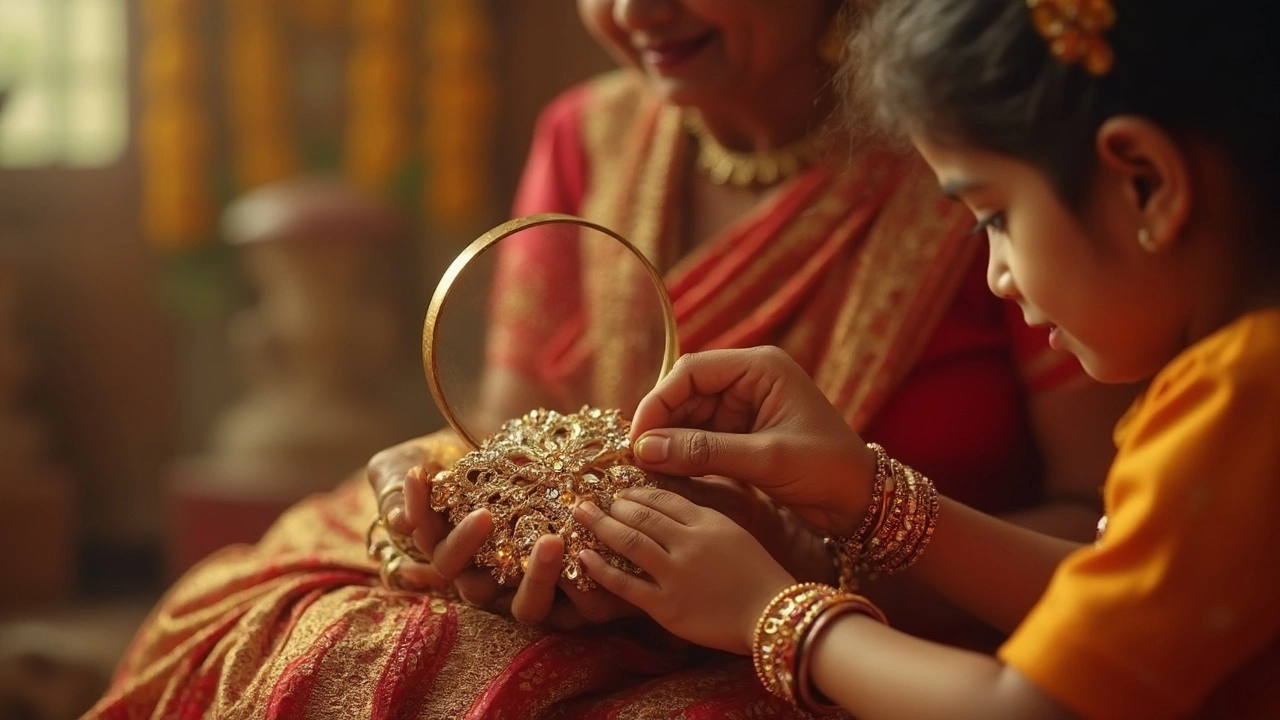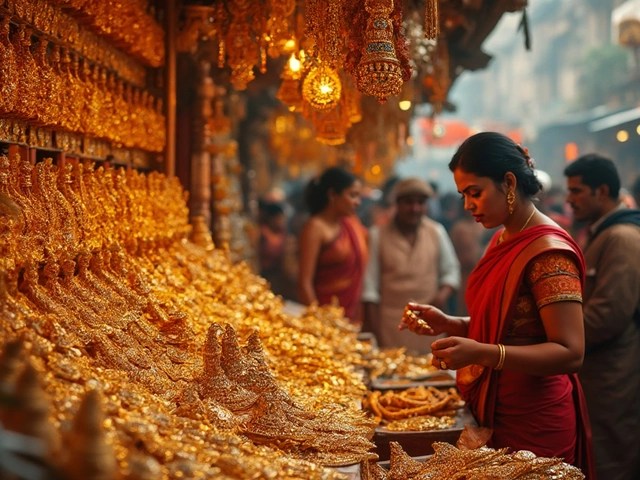
Step into any jewellery shop in India, and you'll probably hear the word “hallmark” tossed around a lot. But what's behind that shiny little stamp on your gold chain or temple necklace? Hallmark gold in India means the piece has been tested for purity by a government-approved center—no guesswork, no shady shortcuts.
If you've ever wondered why two similar-looking gold treasures have different prices, it usually comes down to purity. That’s where hallmarking changes the game. For anyone shopping for temple jewellery, this mark is like your insurance policy. It saves you from knock-offs, lets you know exactly what you’re paying for, and makes selling or exchanging gold down the line way smoother.
- What Hallmark Gold Really Means
- Why Hallmarking Matters for Temple Jewellery
- How to Read a Gold Hallmark in India
- Smart Tips for Buying Hallmarked Temple Jewellery
What Hallmark Gold Really Means
So, what’s the big deal with hallmark gold in India? When you see that little stamped mark on your jewellery, it means a government-authorized center checked and certified your piece for gold purity. This isn’t just about looking pretty or official—it’s about trust.
In India, the Bureau of Indian Standards (BIS) runs the show for hallmarking gold. When you spot a BIS logo along with numbers like 22K or 18K on your temple jewellery, it means experts actually tested the piece for purity. They use pretty high-tech machines to make sure you aren’t getting ripped off with anything less than what you’re buying.
Here’s what usually goes into a true Indian gold hallmark:
- BIS logo (guarantees certification)
- Purity in Karat and its fineness number (like 22K / 916, where 916 means 91.6% pure gold by weight)
- Assaying and hallmarking center’s identification mark
- Jeweller’s own mark or code
- Year of marking (a specific letter each year, like 'A' for 2022, 'B' for 2023, and so on)
Back in 2000, hallmarking in India was totally voluntary. Fast forward to July 2021—it’s now the law in most of the country, so jewellers can’t get away with selling non-hallmarked gold in key areas. For a visual, check out how BIS hallmarking works:
| Type of Mark | What It Means |
|---|---|
| BIS Logo | Certified by Bureau of Indian Standards |
| Karat/Fineness | Shows gold purity, e.g., 22K/916 |
| Assay Center Code | Where it was tested |
| Jeweller ID | Which shop made/sold the piece |
| Year Mark | Year of hallmarking, marked by a letter |
In short, a hallmark gold tag isn’t a fancy decoration. It’s your proof that your money went toward real, authenticated gold—especially important for traditional temple jewellery, where purity isn’t just about looks, but about keeping family traditions safe and sound.
Why Hallmarking Matters for Temple Jewellery
Temple jewellery is not your everyday bling. It’s special, passed down through families, and often bought for big moments—think weddings or religious ceremonies. That’s why the purity of hallmark gold in India isn’t just important; it’s essential. No one wants to spend hard-earned money on fake or low-quality gold, especially when it’s supposed to last generations.
Here’s the thing: temple pieces usually have intricate work, so it’s easy for sellers to hide impurities. A hallmark stamp means your gold has been verified by an independent BIS (Bureau of Indian Standards) center. This protects you from gold filled with cheaper metals or hidden costs down the road. The government made hallmarking compulsory for most gold jewellery from June 2021—so if a shop tries to sell you a temple pendant without a hallmark, that's a giant red flag.
Temple jewellery is also heavy and made in bigger weights than everyday ornaments, so even a small difference in purity can cost you thousands. Hallmarking gives you proof for resale or exchange. If you're planning to gift a temple necklace or use it as an investment, that official stamp is the only thing that can help you get a fair value later on.
Some key reasons why hallmarking is a total game-changer for temple jewellery buyers:
- Gold purity can be checked at a glance—no need to trust just the salesman.
- Exchange or resale is a breeze since certified pieces fetch real prices at jewelers everywhere.
- Peace of mind: Government checks ensure the gold isn’t mixed with cheap stuff.
- You’re protected if you ever need to prove your gold’s value for loans or pawning.
Here’s a quick look at why it matters so much in numbers:
| Jewellery Type | Average Weight (grams) | Potential Loss Without Hallmark (%) |
|---|---|---|
| Temple Necklace | 50-100 | up to 10% |
| Bracelet/Anklet | 30-60 | up to 7% |
| Regular Earrings | 5-15 | up to 5% |
So, with hallmark gold, you’re not just buying jewellery—you’re making a safe, future-proof investment. Skipping that stamp might save a few bucks today, but can mean losing way more in the long run.

How to Read a Gold Hallmark in India
Spotting a real hallmark gold item in India isn’t rocket science, but you do have to know what to look for. A proper Indian hallmark always has a batch of stamped markings. Each of these stamps tells you something important about your gold, and missing just one can mean you’re not getting the real deal.
BIS, or the Bureau of Indian Standards, is the only official body allowed to certify gold in India. Since June 2021, only BIS-hallmarked gold can be legally sold by jewelers. As per BIS rules, every gold ornament should have these four key marks:
- BIS Logo: The triangular BIS mark is the first thing to find. If it’s missing, walk away.
- Purity Mark: This shows karat (like 22K, 18K, or 14K) and its corresponding fineness—so you know what percentage of your piece is pure gold.
- Assaying & Hallmarking Centre’s number: A six-digit alphanumeric code, unique to the certified center that tested your gold.
- Jeweller’s ID: A unique code to the shop or company selling it, so you always know who’s responsible.
Look for all four. In fact, a lot of smart shoppers now use a magnifying glass or even snap a close-up photo to zoom in and double-check. If any of these marks are blurry, missing, or different, that's a red flag. According to official BIS inspections in 2023, nearly 9% of jewellery items checked in traditional markets were missing one or more of these signs—which means lots of folks are still getting fooled.
| Mark | Example |
|---|---|
| BIS Logo | |
| Purity/Fineness | 22K916 (for 22 karat, 91.6% pure) |
| Assay Centre Code | HM/XXXXXX |
| Jeweller’s ID | MUM1234 |
Want to go a step further? Grab the BIS Care app. You just enter the six-digit code from your hallmark gold item and see all the government-verified details pop up on your phone. That's how you stay one step ahead, especially if you’re picking up temple jewellery for family or religious events.
“People assume every shiny gold piece is pure, but the hallmark is the only government-backed proof that counts. Always double-check those four marks, because even the most experienced jeweller can’t eyeball gold purity.” — Pramod Kumar Tiwari, Director General, BIS
If you want to be 100% sure, never buy hallmark gold without these stamps—especially when investing serious money in temple jewellery. Ask the seller to point them out to you before you pay.
Smart Tips for Buying Hallmarked Temple Jewellery
Buying hallmark gold temple jewellery isn’t just about picking the prettiest piece. There are details you should check before handing over your money. Here are steps you don’t want to skip when you’re in the market for genuine temple jewellery in India:
- Check for the BIS logo: The Bureau of Indian Standards (BIS) hallmark is your best friend here. It’s a tiny stamp, but it’s official. No BIS logo? Walk away. This logo means your jewellery has passed strict government tests for gold purity.
- Look for the purity number: Right next to the BIS stamp, you’ll see a number like 916 or 750. 916 stands for 22-karat gold, which is standard for most temple jewellery. 750 means 18-karat. Anything lower, and you’re not getting traditional work.
- Ask for a detailed bill: Always ask for a bill that clearly mentions the gold’s purity, the weight, making charges, and applicable taxes. This protects you if you need to return, resell, or exchange the piece down the road.
- Beware too-good-to-be-true deals: If a shopkeeper offers temple jewellery at a big discount but skips the hallmark, that’s a red flag. Authentic hallmark gold doesn’t come at dirt cheap prices. If you’re saving too much, you’re probably getting less gold than advertised.
- Visit reputable jewellers: Stick to stores and brands known for selling authentic temple jewellery india with proper hallmark gold markings. Look for ones certified by BIS—most big jewellers display this proudly at their shops.
Checking for these details can save you from ending up with fake or low-purity jewellery. According to BIS data released in early 2025, about 80% of urban gold buyers in India now check for hallmarks before making a purchase, up from just 53% in 2021. That’s a big jump—and for good reason. Hallmarked pieces get a better resale value, and you don’t have to fight for a fair deal when you want to upgrade or exchange.
| Feature | What to Look For |
|---|---|
| BIS Logo | Official stamp, not a sticker or engraving |
| Purity Mark | Numbers like 916 (22K) or 750 (18K) |
| Jeweller's Identification | Name or code of the licensed store |
| Year of Hallmarking | Should match the year of purchase |
Don’t let anyone rush you into skipping these checks. With a little patience, you’ll walk away with a piece of temple jewellery that’s not just beautiful—but also a solid investment in pure, true gold.


